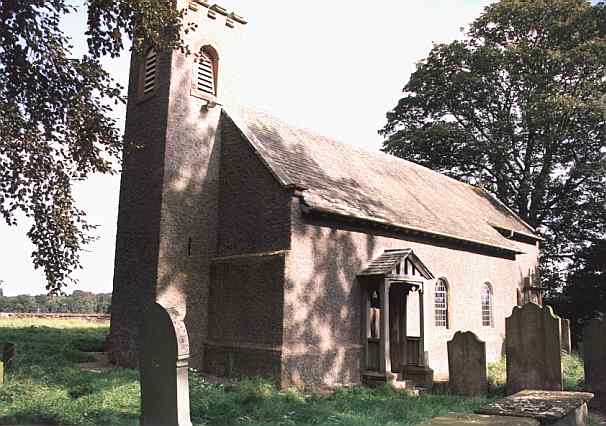 largest land owner in the parish is Mr. Thomas Sibson. This
parish forms a manor within the barony of Burgh, and gave name to a resident family, the
last of whom was Henry de Grinsdale, who left two daughters, whose heirs sold their
inheritance in the reign of Henry IV to the Dentons of Cardew. About the year 1686, George
Denton, Esq. sold his portion of the manor to Sir James Lowther; and the Studholmes
had previously sold the other moiety to the tenants. Upon a rock near the river Eden, are
impressed the foot-steps of a human being, supposed to have occurred when the stone was in
a soft state: they are now covered by the sediment of the river and weeds. The church,
which is dedicated to St. Michael1, was rectorial, until given
to Lanercost Priory by Hugh de Morvil, lord of Burgh. After the dissolution, the rectory
and advowson were given by Edward VI to Sir Thomas Dacre, and the curate has been
constantly appointed by his descendants. The only tithe paid by the parishioners is forty
shillings a year, which was reserved to maintain the ecclesiastical right of the patrons.
The church, which was rebuilt at the sole expense of Joseph Dacre, Esq. about the year
1743, being of a white free stone, is a pretty object on the banks of the Eden. Hutchinson
says "it has been three times augmented by lot, and the lands now (1795) produce £30
a year." The perpetual curacy is at present worth £108 per annum, and is enjoyed by
the Revd. Jonathon Wilson, of Crozier Hall.
largest land owner in the parish is Mr. Thomas Sibson. This
parish forms a manor within the barony of Burgh, and gave name to a resident family, the
last of whom was Henry de Grinsdale, who left two daughters, whose heirs sold their
inheritance in the reign of Henry IV to the Dentons of Cardew. About the year 1686, George
Denton, Esq. sold his portion of the manor to Sir James Lowther; and the Studholmes
had previously sold the other moiety to the tenants. Upon a rock near the river Eden, are
impressed the foot-steps of a human being, supposed to have occurred when the stone was in
a soft state: they are now covered by the sediment of the river and weeds. The church,
which is dedicated to St. Michael1, was rectorial, until given
to Lanercost Priory by Hugh de Morvil, lord of Burgh. After the dissolution, the rectory
and advowson were given by Edward VI to Sir Thomas Dacre, and the curate has been
constantly appointed by his descendants. The only tithe paid by the parishioners is forty
shillings a year, which was reserved to maintain the ecclesiastical right of the patrons.
The church, which was rebuilt at the sole expense of Joseph Dacre, Esq. about the year
1743, being of a white free stone, is a pretty object on the banks of the Eden. Hutchinson
says "it has been three times augmented by lot, and the lands now (1795) produce £30
a year." The perpetual curacy is at present worth £108 per annum, and is enjoyed by
the Revd. Jonathon Wilson, of Crozier Hall.
This parish is entitled to a share of £50, left by Mr. Pattinson, for teaching poor children, and the inhabitants have subscribed towards the building of a school at Kirk Andrews-upon-Eden. It is remarkable that there is not an exciseable article for sale in the whole parish.
Mannix & Whellan, History, Gazetteer and Directory of Cumberland, 1847